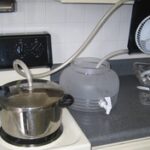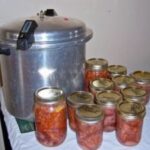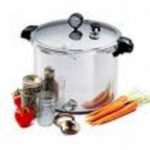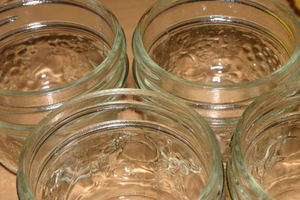Back in olden times, “open kettle” canning was a simple method of canning home grown goods. Open kettle canning meant that you filled a hot jar with hot contents, and screwed on the lid without further processing. As the jar cooled, the lid would self seal.
Some old timers still swear by this method of canning, claiming that no one ever got sick from eating their home canned produce. We now know this is a dangerous way to process food. Without proper processing in a pressure cooker canner, low acid foods canned in the open kettle method are perfect candidates for botulism.
Botulism is an often fatal type of food poisoning. This poison is produced by clostridium botulinum bacterium spores which are found almost everywhere, in the soil, meats, and the food. They are resistant to heat, and thrive in moist, low oxygen conditions. When it comes to home canning, the botulism spores can only destroyed at the higher temperatures achievable by processing the canned food in a pressure cooker. Even high acid foods such as jams, salsa, and fruit canned in by the open kettle method have increased risk of spoilage. This includes the practice of sealing with paraffin or inverting the jars during the cooling process. For preparing high acid foods, a water bath system is the best method of canning.
Don’t count on your nose to tell you if the food is spoiled; some toxins are odorless, colorless, and tasteless. With so much at stake, the safest way to can is by ignoring Grandma’s advice and using the latest, approved methods of food canning as recommended by the USDA. Current canning books and instructions can be found at your local extension office.
So why is open kettle canning dangerous?
I used to have a couple of elderly neighbors who would disagree with me on the dangers of open kettle canning. Every year, they’d ask with a smirk, “And so what’s wrong with the the old way?” while never connecting that the chronic intestinal problems they were dealing with might be connected to their canning practices. There’s several reasons why open kettle canning is no longer safe:
Changes in acidity level
Many of today’s vegetables and fruits have been genetically altered to be tastier and more disease resistant. These changes mean that certain types of food are less acidic, and no longer safe to cook the old fashioned way. Many water bath canning recipes now call for the addition of lemon juice or vinegar to increase the pH levels of these foods, and greatly increased processing times.
Cooler storage
In the old days, houses were quite a bit chillier than they are today. With little in the way of insulation and lack of central heat, the further away a room was from the fireplace, the cooler the temperature. Most home canned goods were stored in those cooler and unused rooms, which tended to keep a consistent temperature just slightly above freezing. These rooms basically acted as refrigerators and lowered the chances of spoilage. Even today, canning books today recommend that the optimal storage temperatures for canned foods should be between 50-70 degrees.
Less long term storage
In the old days, food was also scarcer and families didn’t hoard food for years and years. Most of what was canned during harvest time was consumed by early spring. Shorter storage time meant lesser opportunities for spoilage, and that the food was usually eaten before those warm summer temperatures raised the temperature of the store rooms. Most canning books today recommend that home canned goods now be consumed within a year of processing.
Home canning can be an enjoyable and perfectly safe pastime when done correctly. And while Grandma may insist that “open kettle canning” is perfectly acceptable, when it comes to safety, the best canning advice comes from the canning experts at your local county extension office.
Sources:
Kerr Home Canning and Freezing Book. Alltrista Corporation, 1996.
http://www.backwoodshome.com/articles/case66.html




